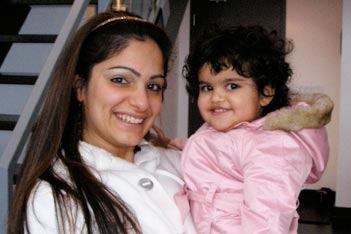Spinal Surgery at U of T

Raj Rampersaud
|
Raj Rampersaud completed orthopaedic surgery residency and a spine fellowship at
the University of Western Ontario. He studied neurosurgery (spine) in Memphis with
Kevin Foley who mentored him in early techniques of minimal access spine surgery.
This approach to spinal stenosis is growing in popularity, especially for aging
patients. Stenosis surgery previously required a three to four day hospital stay;
it is now performed as day surgery. The general perception, even among practitioners,
is that outcomes of surgery for the aging spine are negative, so the barrier to
adopting minimally invasive techniques, often resisted because of the learning curve,
wasn't as high as it might have been. Now it is gaining momentum. There is a widespread
misperception that patients treated by surgery for spine problems have no better
outcomes than those who have no surgery. While this may be so for indiscriminate
surgical treatment of back pain, it is not so for the majority of degenerative disorders
that undergo spinal surgery, such as radiculopathy or neurogenic claudication.
In addition this erroneous view derives from recent studies such as the intent-to-treat
analysis of the large randomized SPORT trial (1), widely misinterpreted in the media.
Patients with symptomatic lumbar disc herniation were randomly assigned to surgery
or medical treatment. 30% of "non-surgical patients" could not adhere to their assigned
treatment. Their crossover to surgical treatment accounts for the good outcomes
they experienced and the apparent equivalence. While the media megaphone enjoyed
implying excessive and unnecessary surgery, the under reported as-treated analysis
showed that surgical patients enjoyed strong, statistically significant advantages
at all follow-up times.
Raj's academic mission is to distinguish his work from the clouded record of disc
surgery. "The key to good outcomes from spine surgery is patient selection." We
need to learn what we can and cannot fix; an abnormal MRI is not necessarily a reason
to operate, nor is back pain. For patients with stenosis and back pain, but no neurogenic
claudication, surgical intervention is not reliably effective; for those with neurogenic
claudication, operations have a success rate of 80-90%, comparable to the success
rate of hip and knee surgery. Raj's important academic paper published in The Spine
Journal (2) showed that overall improvement in quality of life after two years following
spinal decompression, measured by SF 36, was similar to that attained following
total hip or knee replacement.
Having developed minimally invasive techniques, Raj is now able to do spine surgery
more quickly than before. He does about 200 spine cases a year, ranging from minimal
access to maximal. 40% of his practice is now day surgery, up from about 10% when
he started eight years ago.
Academically Raj's focus is on objective analysis of outcomes, using quality of
life measures like SF 36. The importance of evaluating outcomes was impressed upon
him during his residency in London where it was emphasized as the best way to improve
practice. Hip and knee replacement surgeons see screened patients who are good candidates
for surgery. The screening and prehabilitation program for those patients is described
in the article "Hip and Knee Replacement" in the Spring 2006 issue of the Spotlight.
Spine surgeons are still inundated with patients who are not good candidates (approximately
80%) for surgery -- not a good way to manage wait times.
|
The University of Toronto has a rich history of spine surgery, but it has been stored
traditionally in separate specialty silos. Recently there have been more opportunities
for cross training, with spine surgeons coming from both orthopaedic and neurosurgery.
Raj is one of fourteen dedicated spine surgeons, a concentration unique to Toronto.
He and his colleagues are developing a U of T Spine Program to enhance collaboration
among specialties to focus on spine surgery. It will include scholars in biomechanics
at Sunnybrook like Cari Whyne and surgeon-scientists in regenerative medicine like
Michael Fehlings and Charles Tator. The group is searching internally for a director
for the program. They will focus on education by creating combined rounds and fellowships,
on collaborative research, and on interprofessional patient care. They are developing
a model of care that will screen patients, directing those who are not good candidates
for surgery to appropriate specialists.

Samina Rampersaud with daughter Amira
|
Raj originally thought he would be an engineer -- his whole family is mechanically
inclined. His father, who was a dentist in Guyana, is a hands-on person who could
fix anything. The humanistic aspect and the flexibility of medicine made Raj choose
this direction instead. He developed an interest in sports medicine while playing
high school football, and was inspired by orthopaedic surgeons while in medical
school. He chose spine surgery over sports medicine eventually because of the challenges,
the academic potential and the need for spine surgeons. His mentors in London, orthopaedic
surgeons Kevin Gurr and Stewart Bailey, piqued his interest in this field. Kevin
Foley, his neurosurgery mentor in Memphis is a thoughtful practitioner of patient-centred
care who taught Raj to look for the next step needed to improve surgical practice.
A locum in Brantford gave him a valued community perspective.
Raj has been married to Samina for five years. Their 18-month-old daughter is named
Amira, which means "princess". Raj and Samina take karate and home cooking classes.
They live on the waterfront and enjoy biking there. They enjoy travelling in Europe
and North America focussing on meeting and understanding local people and customs.
M.M.
(1) Weinstein JN, Tosteson TD, Lurie JD, et al. Surgical vs Nonoperative Treatment
for Lumbar Disk Herniation: the Spine Patient Outcomes Research Trial (SPORT). JAMA.
November 22/29, 2006;296(20):2441-2450.
(2) Rampersaud YR, et al. Assessment of health-related quality of life after surgical
treatment of focal symptomatic spinal stenosis compared with osteoarthritis of the
hip or knee. The Spine Journal. (in press.)
|